It’s still Π Day for a few minutes more here in the Eastern Time Zone, and I know it goes without saying, but what a holiday it’s been. Yet I still long for the simpler Π Days of my childhood. It’s all so commericial now, with the Π Nog Lattes at Starbucks and Justin Beiber’s cover of “Do They Know it’s Π Day?” on constant repeat on the mall’s muzak system. And that’s not to mention that fake precision that’s all the rage with the tweens, their memorizing π to all those places. ((Again, I blame Beiber and his recent eighteen hour long single, ‘I’m Just Going to Recite the Digits in π for 18 Hours (Because, Girl, You’ll Buy Anything I Put Out)’.)) “In my day, ((When I lived two streets down from Archimedes.)) π was between 3.1408 and 3.1429 and that was good enough for us, consarnit! ((Archimedes used to say consarnit all the time, I swanny.))
[continue reading…]
{ 5 comments }
A reader (who asked to remain anonymous) ((For obvious reasons. Why risk your name becoming associated with the #1 internet destination for medieval porn?)) poses the following question:
Have you seen this image of apes playing Ring Around the Rosie to ward off the plague at the Walters Museum’s site? I thought that explanation for that song had been debunked.
As it turns out, I hadn’t seen the image, so thank you, anonymous reader, for bringing this to us all:
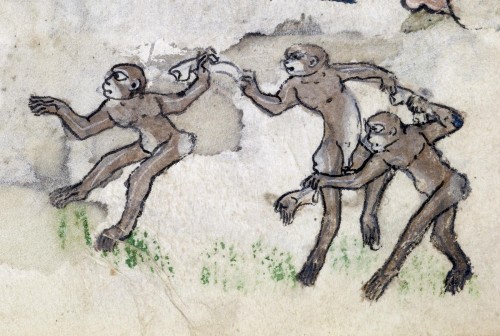
Are these monkeys ((Yes, yes, I know they’re apes. Monkeys is a cooler word than apes.)) trying to ward off the plague? Not at all. Don’t blame the museum exhibiteers, though. It’s a very old mistake with an august history.
[continue reading…]
{ 8 comments }
These days, it’s getting harder and harder to track down pictures of nuns riding flying fish, or fighting off hordes of misshapen pygmies, or falling prey to the fiendish war machines of the ape king. And if you want medieval-inspired versions of the same, forget about it!
That’s what I used to think, anyway, until I stumbled across the works of Marcel Ruijters, an artist from Rotterdam who’s taken the sorts of weird medieval art I feature here regularly in Mmm… Marginalia and doubled down on the weird, with some pretty cool results.
For example, aforementioned warrior nuns, fighting aforementioned weird hybrid men:
{ 6 comments }
I moved to a new place recently, so I have been hitting the local consignment shops pretty hard in search of new furnishings. Thankfully, the major furniture purchases are all behind me and now all that’s left to acquire are the pictures, lamps, and other decorative bits and bobs that round a place out. ((I’m still searching for a rug that will really tie the room together.)) To that end, this afternoon I dropped into Estate Gallery Consignments ((Who I’d link to if they had a webpage. If you live in Atlanta and want to visit them, go to that part of Chamblee where all the antique stores are stacked on top of each other five deep.)) and stumbled across this on a back shelf:
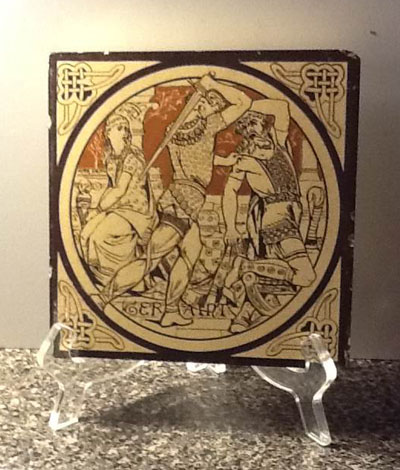
I snapped it up because I vaguely recognized the scene as Arthurian, ((And the price as $8, well within my knickknack budget.)) though I don’t know how exactly, as I didn’t see the name “Geraint” (which is clear as day now) until I got home. Turns out the tile depicts a scene from Tennyson’s Idylls of the King, Geraint slaying Dorm. It’s part of a 12-tile set that illustrates the full cycle, designed by John Moyr Smith around 1875 for the Minton Tile Company. ((The same tile company that tiled part of the White House.)) I’m assuming mine’s a fake, but either way, I’m glad to have stumbled across it, as I’d never known till today that the Victorians sometimes tiled their washrooms with scenes of dudes with swords hacking up other dudes–Arthurian dudes or otherwise.
{ 9 comments }
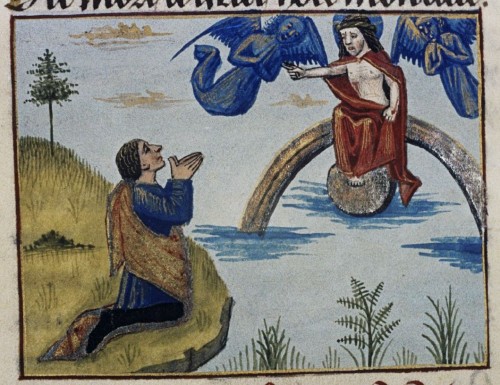
Sorry, God of Love, today we don’t need your advice. We’re going straight to the horse’s mouth. And other animal’s mouths, as well.
We’ve spoken before about how awesome medieval bestiary lore is, but I fear I’ve given the impression that it’s all self-castrating beavers and Christ signification. ((How many times can I link the same post before people start to get annoyed? Have to ask the SEO folks if I’m optimizing my eyeball retention synergies right.)) It is both of those things, of course, but there’s so much more! Seeing that today is the Feast of St. Valentine, I thought you all might be interested to learn that bestiaries have an awful lot to say ((And not a bit of it bestiality-related. Sorry if that disappoints, but this is a family friendly blog when Reynard’s♣ not mucking it up.
♣ Oh, precious little funny man, against the invasions of Reynard, you are entirely impotent–and I mean that sexually, as well. It is a double entendre, which is what we French call it when a thing means one thing and another that is sexual. Like when I say to your wife that I wish to come by and give her a gift, and the gift is my penis, which she is happy about because of your impotence. And then I take the jewelry you gave her as gifts and sell it to the pawn broker. And then I use the money at the whorehouse. See, so many entendres Reynard possesses! But I digress. Carry on, impotent ignorant, unwashed Blogger.)) about love–well, one bestiary in particular does, at least, the aptly named Bestiaire d’Amour–that is, The Bestiary of Love.
Written in the first quarter of the 14th century, Richard Fournival’s Bestiary of Love takes the form of a male lover’s argument with his female counterpart in which he explains how the various important facts about animals apply equally well to people in love. It was a popular enough text that it survives (in part) in a fair number of manuscripts and spawned a couple continuations and even a Response written as if from the lady, disputing all those things her male counterpart said about the animals. ((You can read both in Jeanette Beer’s Beasts of Love: Richard de Fournival’s Bestiaire d’amour and the Response, available for an absurd price from Amazon. I don’t have a copy on hand,† so today I’ll be limiting the discussion to the male half.
† Though if someone wants to send me one through my Amazon Wishlist, ♣♣ maybe a sequel post will materialize that gives the female side of the story.
♣♣ Yes, yes, very clever Blogger of the Unclean Feminine Undergarments. No one will think poorly of you for your blatant plea for financial compensation hidden in a footnote.)) The Bodleian has a particularly lovely copy (MS Douce 308), so let’s peek between the pages and see what the animals have to teach us about love.
First up, there’s my usual obsession, The Monkey. ((Alas, the flash off the gold leaf makes the hunter hard to make out. This is a problem with a lot of the images to come, so just bear with.))
[continue reading…]
{ 7 comments }
 Greetings once more, gentle readers,
Greetings once more, gentle readers,
Mayhap thou remembrest me? It be’st I, Sir Ten-to-Three, formerly Baby New Year 1023, the same soul who didst some months past gain some small pittance of coin from yon King of This Blog, long mayest he reignest, by listing the posts of his majesty’s that once werest posted on the holiday of Christmas, once upon a time. Today, I maketh a return engagement in order that you may be revisited by the posts that formerly marked the Feast of St. Valentine.
{ 0 comments }
While I am much obliged to the New Yorker’s blog gremlins for linking my recent post on naked dudes and nuns, I must grumble a bit over their word choice. To wit:
Girls just want to have fun: surprising marginalia doodled by medieval nuns. [Emphasis mine.]
Put aside the issue of errant agency clause, ((It wasn’t the nuns that made the pictures of naked dudes. They were made for a nun, not by.)) because it’s the word “doodle” that really riles my pedantic dander. Granted, it’s not the first time that a marginalia post of mine has been disseminated to teh wider internets under the heading of “doodle,” ((And it probably won’t be the last.)) but it still irks me, because, as I try to make clear, the images I post here on Mondays ((Or on Thursdays and backdated to Mondays, as the case may be.)) weren’t scribbled into the margins by surreptitious snarkers whilst no one was looking. They were explicitly commissioned by the manuscript’s patrons as part of the project from the very beginning. For the well-heeled noble, ordering a book was not just a matter of selecting the text; deciding on size, presentation, illustration, and ratio of naked dudes to non-naked dudes in the margins was all part of the process of getting a book made.
[continue reading…]
{ 11 comments }
As faithful fans of Terry Pratchett know well, the hedgehog can never be buggered at all. Behold, a poor marginal monkey who just learned that the converse does not hold:
{ 4 comments }
Each Thursday, I’ll be stringing together some of the disconnected thoughts I’ve had about the subject of my dissertation in a feature I call “Thesis Thursday“. This week had two Thursdays, as last week I took a bye, so enjoy the second post of the week:
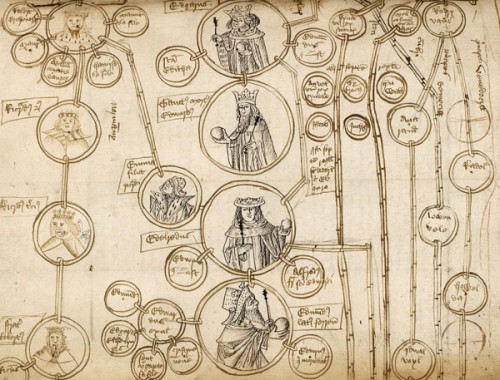
There is one loose thread from my last post that I want to circle back and pick up before moving on. ((Don’t worry, I’m tying one end of the thread here to this post, so if we get lost all we have to do is follow it back. Though if we run into a minotaur, things might get dicey.)) I said before that Geoffrey fashioned his King Constantine, the father of Uther and grandfather of Arthur, out of details from two different historical Constantines, 1) Constantine III, the Roman soldier stationed in Britain at the beginning of the fifth century who briefly usurped the imperial seat, and 2) Constantine of Cornwall, a descendant of Conan Meriadoc, the legendary British founder of Brittany. I also said that the usual read on Geoffrey’s composite Constantine is either confusion or conflation, but that I prefer to see the hand of Geoffrey the artist at work instead. Out of the fragments of historical information available to him, Geoffrey purposely selected details that would further the story he was telling and help him more fully integrate Arthur into the grand story of Britain itself.
[continue reading…]
{ 6 comments }

Guess which big-budget summer blockbuster starring Robert Downey, Jr., the creators of FMJ watched before pitching the show. (Remember, The Sherlock Holmeses both came out in December.)
♣ I would not be so sure about that, porcine sodomite–and while we are on the subject, you should surely lose some weight so that you could fit your pale, quivering fleshy bits into a fine Medieval War Axe Pinstripe Mens Vests such as can be found currently at Buy.com for only $39.98 with free shipping, a savings of over 49% off a price they clearly fabricated by multiplying the desired sales price by 2.))
But the most recent inbox volley brought an offer I don’t mind taking them up on, an ad for a new show called Full Metal Jousting that’s debuting Sunday week on the History Channel. ((You know, the Alien, Hitler, and Alien Hitler network.))
What I learned from their free preview, which you can see by clicking the only slightly intrusive javascript widget above, is as follows:
[continue reading…]
{ 8 comments }

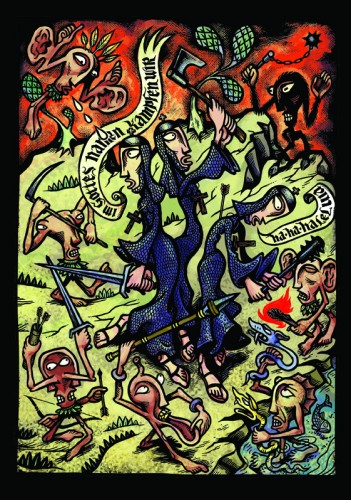
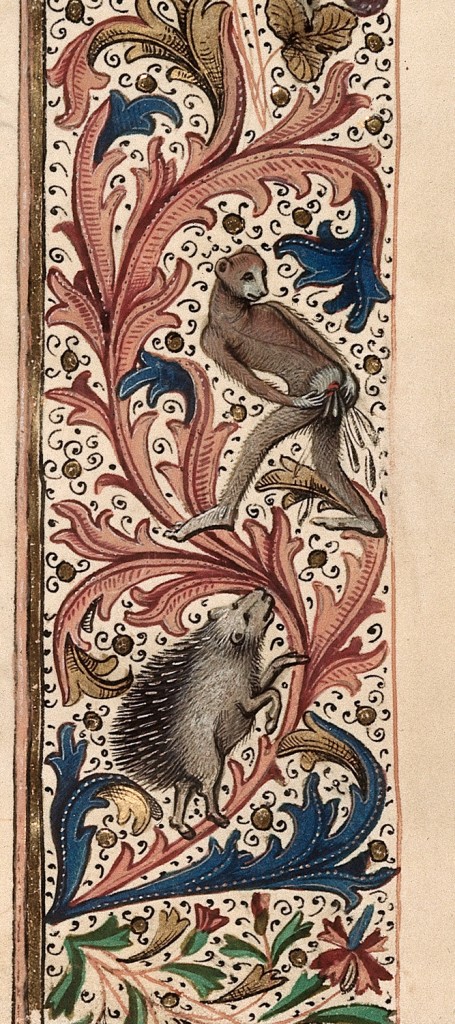
Recent Comments